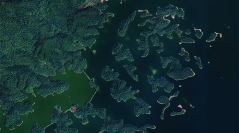

 Cryptogamie, Bryologie
44 (6) - Pages 133-160
Cryptogamie, Bryologie
44 (6) - Pages 133-160Understanding patch attributes influencing biological diversity in fragmented habitats is of critical importance for biodiversity conservation. We investigated the bryophytes and six patch attributes (habitat diversity, area, elevation, isolation degree, vegetation coverage, and shape irregularity) across 168 islands in the Thousand Island Lake (TIL), China. Multivariate analyses showed that the six patch attributes explained 68.1% of the species richness (SR) variation and 13.3% of the species composition (SC) variation. Habitat diversity explained 55.5% of the total SR variation (8.4% by habitat diversity per se and 47.1% confounded by the remaining variables). Although area, vegetation coverage, shape irregularity, and elevation independently explained only 0.4% to 2.4% of the total SR variation, respectively, a large part of their effects were confounded with the other patch attributes. All surveyed patch attributes imposed weak but significant influences on bryophyte SC, independently accounting for 0.8-1.5% of the total SC variation. Analyses using the generalized linear mixed models (GLMMs) showed that habitat diversity was the most important determinant of bryophyte SR, followed by elevation, area, isolation degree, vegetation coverage, and shape irregularity. All six patch attributes exerted positive effects on SR except isolation degree. Area, elevation, and shape had a positive interaction effect on bryophyte SR. Our results imply that a subtropical forest reserve for bryophyte conservation had better be designated to have high habitat diversity, a large area, a large elevation range, and irregularly-shaped fragments adjacent in distance.
Environmental factor, generalized linear mixed models, multivariate analyses, species richness, species composition